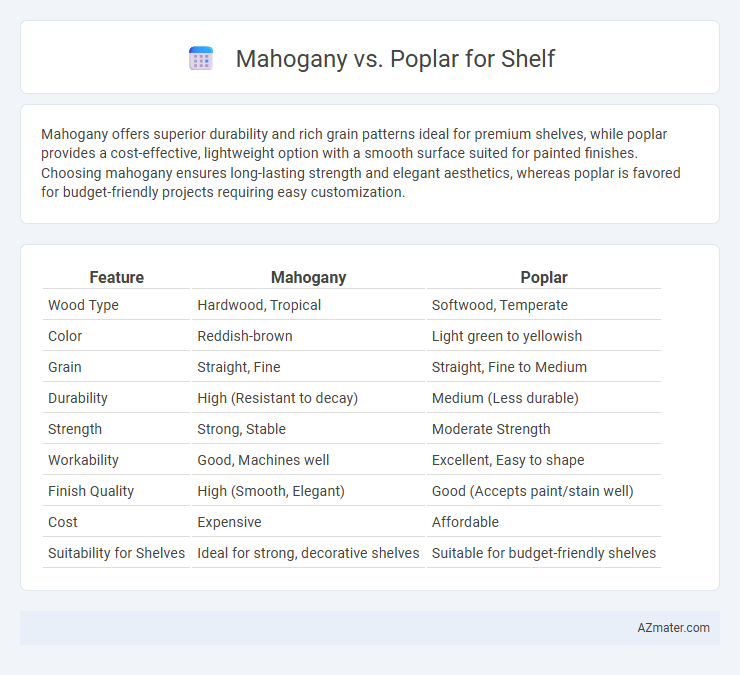Mahogany offers superior durability and rich grain patterns ideal for premium shelves, while poplar provides a cost-effective, lightweight option with a smooth surface suited for painted finishes. Choosing mahogany ensures long-lasting strength and elegant aesthetics, whereas poplar is favored for budget-friendly projects requiring easy customization.
Table of Comparison
| Feature | Mahogany | Poplar |
|---|---|---|
| Wood Type | Hardwood, Tropical | Softwood, Temperate |
| Color | Reddish-brown | Light green to yellowish |
| Grain | Straight, Fine | Straight, Fine to Medium |
| Durability | High (Resistant to decay) | Medium (Less durable) |
| Strength | Strong, Stable | Moderate Strength |
| Workability | Good, Machines well | Excellent, Easy to shape |
| Finish Quality | High (Smooth, Elegant) | Good (Accepts paint/stain well) |
| Cost | Expensive | Affordable |
| Suitability for Shelves | Ideal for strong, decorative shelves | Suitable for budget-friendly shelves |
Introduction to Mahogany and Poplar
Mahogany is a durable hardwood prized for its rich reddish-brown color, fine grain, and resistance to warping, making it ideal for high-quality shelves. Poplar, a softer hardwood, features a pale yellow-green to white color with a straight grain, offering an affordable and lightweight option for shelving projects. Both woods vary significantly in hardness and appearance, influencing shelf durability and aesthetic.
Wood Characteristics: Mahogany vs Poplar
Mahogany features a rich reddish-brown color with a fine, straight grain that offers exceptional durability and resistance to warping, making it ideal for long-lasting shelves. Poplar presents a lighter, creamy white to pale yellow hue with a softer texture and more pronounced grain patterns, which can be prone to dents but is easier to paint and finish. Both woods provide distinct aesthetic and functional benefits, with mahogany excelling in strength and appearance, while poplar is favored for affordability and versatility in painted projects.
Strength and Durability Comparison
Mahogany offers superior strength and exceptional durability, making it ideal for heavy-duty shelves that withstand significant weight and wear over time. Poplar, while lighter and easier to work with, has less density and is more prone to dents and scratches, reducing its lifespan in high-stress applications. For long-lasting, robust shelving solutions, mahogany is the preferred choice due to its hardness and resistance to warping.
Appearance and Grain Patterns
Mahogany shelves exhibit rich reddish-brown hues with a smooth, straight grain that deepens in color over time, offering a classic and elegant appearance. Poplar features a lighter, pale yellow to greenish tone with a more uniform, fine grain that is often less visually striking but easier to paint or stain for customizable finishes. The choice between Mahogany and Poplar depends on whether a warm, luxurious look or a versatile, paint-friendly surface is preferred for the shelf.
Workability: Cutting, Shaping, and Finishing
Mahogany offers superior workability with its fine, even grain, making cutting, shaping, and finishing smooth and precise, ideal for intricate woodworking on shelves. Poplar is easier to cut and shape due to its softer texture but may require more effort when finishing to achieve a smooth, blemish-free surface. Both woods accept stains and paints well, but mahogany's natural luster enhances finishes without extensive preparation, unlike poplar, which often needs sealing to avoid blotchy results.
Weight and Load-Bearing Capacity
Mahogany offers superior load-bearing capacity compared to poplar due to its dense, hardwood structure, making it ideal for heavy-duty shelving applications. Poplar is lighter in weight, which facilitates easier handling and installation but sacrifices some strength and durability under substantial loads. Choosing mahogany ensures higher weight tolerance and long-term stability for shelves holding heavy items, whereas poplar suits lighter storage needs.
Cost and Availability
Mahogany shelves typically command a higher price due to their durability, rich grain, and limited availability compared to poplar, which is more cost-effective and widely accessible. Poplar wood is commonly sourced from fast-growing trees, making it an economical choice for budget-conscious projects, while mahogany's slower growth and tropical origins contribute to its scarcity and premium cost. Availability of mahogany varies by region and may require import, whereas poplar is readily stocked in most North American lumber suppliers, enhancing its convenience for timely shelf production.
Environmental Impact and Sustainability
Mahogany and poplar differ significantly in environmental impact and sustainability, with poplar regarded as a faster-growing, more renewable hardwood due to its shorter harvest cycles and widespread availability in managed plantations. Mahogany, often sourced from tropical rainforests, faces criticism for deforestation and habitat destruction unless certified by organizations like the FSC (Forest Stewardship Council) for sustainable harvesting. Choosing poplar for shelving contributes to lower carbon footprints and reduced ecological damage, making it a preferable option for environmentally conscious consumers.
Maintenance and Longevity
Mahogany offers superior durability and resistance to wear, requiring minimal maintenance to retain its rich appearance over time, making it ideal for long-lasting shelves. Poplar, while more affordable and easier to work with, tends to be softer and more prone to dents and scratches, demanding more frequent touch-ups and protective finishes to ensure shelf longevity. Choosing mahogany provides a more robust and low-maintenance solution, whereas poplar suits budget-friendly projects with a willingness for regular upkeep.
Which Wood is Better for Shelves?
Mahogany offers superior durability and a rich, deep color, making it ideal for high-end, long-lasting shelves that resist warping and scratches. Poplar is a more affordable, lightweight option with a softer texture and lighter color, suited for painted or budget-friendly shelving projects. For shelves requiring strength and an elegant appearance, mahogany is the better choice, while poplar fits well in cost-effective and easily customizable shelving solutions.

Infographic: Mahogany vs Poplar for Shelf
 azmater.com
azmater.com